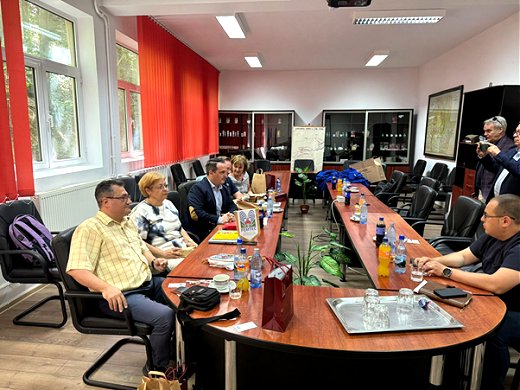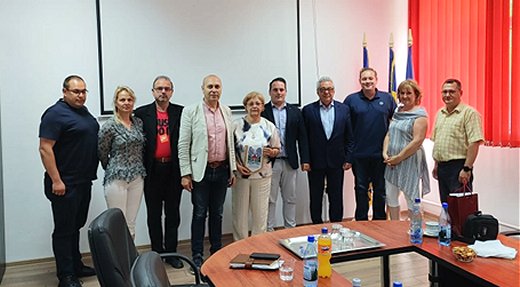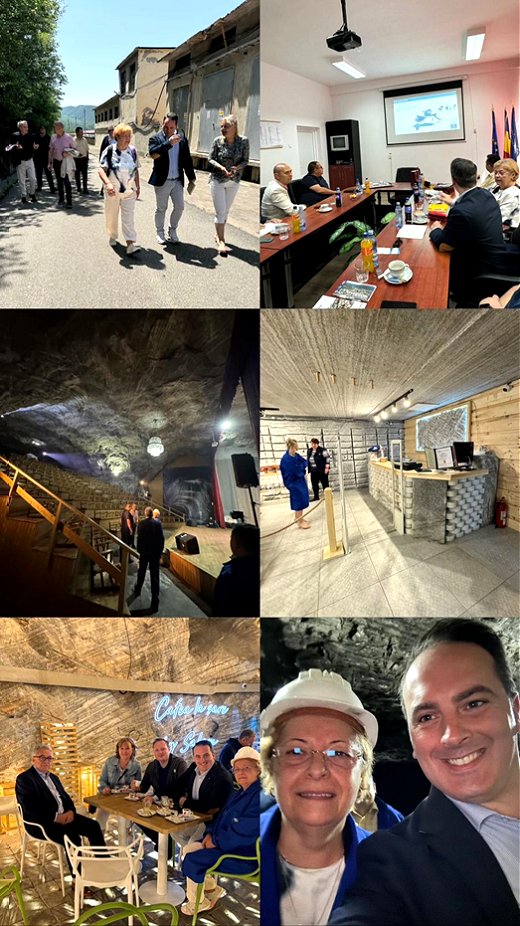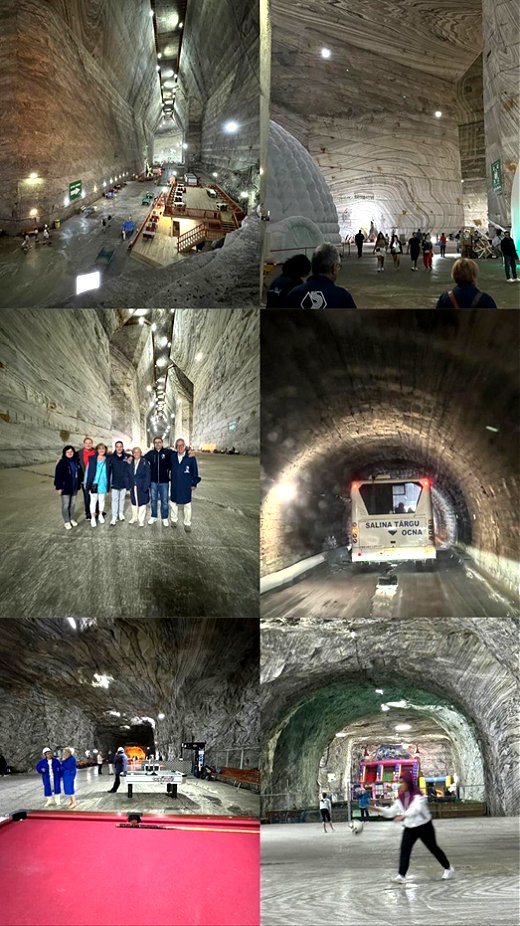 FEMTEC new initiative to promote the microclimate from former salt mine galleries
Improving the cooperation in the field of hydrotherapy and climatotherapy
Under the patronage of FEMTEC and according to its mission to improve cooperation in the field of hydrotherapy and climatotherapy, during June, 20th-23rd, a French delegation from Varangéville visited two salt mines in Romania that offer medical facilities, but also tourism, for wellness activities as microclimate therapy. The French delegation included the mayor of Varangéville, Mr. Christopher Varin and two members of the local council, respectively Ms. Dominique Lamontagne and Mr. Alexandre Louis.
The objective of the visit was presentation of traditional benefits of using the microclimate of former salt mines galleries as a medical and wellness use of salt mines microclimate.
The FEMTEC President organized the visit and the meetings with: leadership of The National Salt Company S.A.-Salrom, of Salt the Mine Targu Ocna and Slanic Prahova, of Romanian Association of Balneology and of Romanian Society of Physical and Rehabilitation Medicine&Balneoclimatology.

This natural therapeutic approach known under different denominations: speleotherapy, halotherapy, inhale therapy, aerosols therapy remains scientifically almost unknown due to lack of evidence-based proofs. It is an Eastern Europe medical tradition known and used in Romania, Ukraine, Poland and consists in using microclimate conditions from former galleries of salt mines to prevent and/or treat some medical conditions, such as respiratory and skin diseases.
In those countries local tradition is strong and kept alive this popular approach (mostly empiric) of visiting on a daily basis, under the form of salt mine course (10 - 12 days in a row), the former galleries, yearly and coming back many years in a row, especially those peoples suffering of frequently winter ORL infection and/or asthma, bronchitis, eczema and other skin diseases, etc.
When the industrial activity comes to end, the remained galleries are very stable inner spaces and they can be set up to be open for hundreds of persons, under safe conditions. The Targu Ocna salt mine receives each year 230,000 and Slanic Prahova salt mine receives 340,000 tourists and/or patients/year.

Scientific evaluation of the impact of salt mines microclimate on human physiology and on different medical conditions, in line with the requirements of evidence-based medicine is poor. The participants agreed to promote international cooperation between scientific institutions and other public or private organizations from their country, to organize and carry out studies and research, promote knowledge, sharing on technical and scientific issues related to salt mines microclimate.
All participants agreed to have periodically reunions to continue the exchanges and dialog enriching scientific medical knowledge, to open a new perspective on traditional, complementary and integrative medicine and to contribute to the integration in health services.
 |
BACK TO MAIN PAGE
|
|
|
 FEMTEC new initiative to promote the microclimate from former salt mine galleries
Improving the cooperation in the field of hydrotherapy and climatotherapy
Under the patronage of FEMTEC and according to its mission to improve cooperation in the field of hydrotherapy and climatotherapy, during June, 20th-23rd, a French delegation from Varangéville visited two salt mines in Romania that offer medical facilities, but also tourism, for wellness activities as microclimate therapy. The French delegation included the mayor of Varangéville, Mr. Christopher Varin and two members of the local council, respectively Ms. Dominique Lamontagne and Mr. Alexandre Louis.
The objective of the visit was presentation of traditional benefits of using the microclimate of former salt mines galleries as a medical and wellness use of salt mines microclimate.
The FEMTEC President organized the visit and the meetings with: leadership of The National Salt Company S.A.-Salrom, of Salt the Mine Targu Ocna and Slanic Prahova, of Romanian Association of Balneology and of Romanian Society of Physical and Rehabilitation Medicine&Balneoclimatology.

This natural therapeutic approach known under different denominations: speleotherapy, halotherapy, inhale therapy, aerosols therapy remains scientifically almost unknown due to lack of evidence-based proofs. It is an Eastern Europe medical tradition known and used in Romania, Ukraine, Poland and consists in using microclimate conditions from former galleries of salt mines to prevent and/or treat some medical conditions, such as respiratory and skin diseases.
In those countries local tradition is strong and kept alive this popular approach (mostly empiric) of visiting on a daily basis, under the form of salt mine course (10 - 12 days in a row), the former galleries, yearly and coming back many years in a row, especially those peoples suffering of frequently winter ORL infection and/or asthma, bronchitis, eczema and other skin diseases, etc.
When the industrial activity comes to end, the remained galleries are very stable inner spaces and they can be set up to be open for hundreds of persons, under safe conditions. The Targu Ocna salt mine receives each year 230,000 and Slanic Prahova salt mine receives 340,000 tourists and/or patients/year.

Scientific evaluation of the impact of salt mines microclimate on human physiology and on different medical conditions, in line with the requirements of evidence-based medicine is poor. The participants agreed to promote international cooperation between scientific institutions and other public or private organizations from their country, to organize and carry out studies and research, promote knowledge, sharing on technical and scientific issues related to salt mines microclimate.
All participants agreed to have periodically reunions to continue the exchanges and dialog enriching scientific medical knowledge, to open a new perspective on traditional, complementary and integrative medicine and to contribute to the integration in health services.
 |
BACK TO MAIN PAGE
|
|
 FEMTEC new initiative to promote the microclimate from former salt mine galleries
Improving the cooperation in the field of hydrotherapy and climatotherapy
Under the patronage of FEMTEC and according to its mission to improve cooperation in the field of hydrotherapy and climatotherapy, during June, 20th-23rd, a French delegation from Varangéville visited two salt mines in Romania that offer medical facilities, but also tourism, for wellness activities as microclimate therapy. The French delegation included the mayor of Varangéville, Mr. Christopher Varin and two members of the local council, respectively Ms. Dominique Lamontagne and Mr. Alexandre Louis.
The objective of the visit was presentation of traditional benefits of using the microclimate of former salt mines galleries as a medical and wellness use of salt mines microclimate.
The FEMTEC President organized the visit and the meetings with: leadership of The National Salt Company S.A.-Salrom, of Salt the Mine Targu Ocna and Slanic Prahova, of Romanian Association of Balneology and of Romanian Society of Physical and Rehabilitation Medicine&Balneoclimatology.

This natural therapeutic approach known under different denominations: speleotherapy, halotherapy, inhale therapy, aerosols therapy remains scientifically almost unknown due to lack of evidence-based proofs. It is an Eastern Europe medical tradition known and used in Romania, Ukraine, Poland and consists in using microclimate conditions from former galleries of salt mines to prevent and/or treat some medical conditions, such as respiratory and skin diseases.
In those countries local tradition is strong and kept alive this popular approach (mostly empiric) of visiting on a daily basis, under the form of salt mine course (10 - 12 days in a row), the former galleries, yearly and coming back many years in a row, especially those peoples suffering of frequently winter ORL infection and/or asthma, bronchitis, eczema and other skin diseases, etc.
When the industrial activity comes to end, the remained galleries are very stable inner spaces and they can be set up to be open for hundreds of persons, under safe conditions. The Targu Ocna salt mine receives each year 230,000 and Slanic Prahova salt mine receives 340,000 tourists and/or patients/year.

Scientific evaluation of the impact of salt mines microclimate on human physiology and on different medical conditions, in line with the requirements of evidence-based medicine is poor. The participants agreed to promote international cooperation between scientific institutions and other public or private organizations from their country, to organize and carry out studies and research, promote knowledge, sharing on technical and scientific issues related to salt mines microclimate.
All participants agreed to have periodically reunions to continue the exchanges and dialog enriching scientific medical knowledge, to open a new perspective on traditional, complementary and integrative medicine and to contribute to the integration in health services.
 |
BACK TO MAIN PAGE
|
|
|

